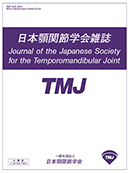All issues

Volume 25 (2013)
- Issue 3 Pages 163-
- Issue 2 Pages 81-
- Issue 1 Pages 3-
Predecessor
Volume 25, Issue 2
Displaying 1-3 of 3 articles from this issue
- |<
- <
- 1
- >
- >|
case report
-
Atsushi FUJITA, Toyonori SUZUKI, Satoru SHINTANI2013Volume 25Issue 2 Pages 81-86
Published: 2013
Released on J-STAGE: October 15, 2013
JOURNAL FREE ACCESSA 72-year-old woman, who had dementia and Parkinson's disease, was referred to our department due to difficulty of mouth closing for over three months. Panoramic radiograph, CT and MR images showed that the bilateral condyle was completely dislocated anterior to the articular eminence. Since noninvasive reduction treatment for three weeks failed, eminectomy was performed under general anesthesia. Thereafter, mandibular traction was performed for three months postoperatively. She recovered normal masticatory function without recurrence of dislocation.
View full abstractDownload PDF (754K) -
Takuya MURAKAMI, Shinya KOSHINUMA, Tomoki HIGO, Gaku YAMAMOTO2013Volume 25Issue 2 Pages 87-91
Published: 2013
Released on J-STAGE: October 15, 2013
JOURNAL FREE ACCESSMany studies have reported on extraoral open reduction and fixation for mandibular ramus fractures. However, extraoral open reduction and fixation of mandibular ramus fractures may induce surgical complications, such as risk of facial nerve injury and creation of visible scars. To avoid these complications, we used a contra-angle driver to perform intraoral open reduction and fixation on three patients with mandibular ramus fractures.
All patients showed no dysfunction in the postoperative period and the anatomic alignment of the mandibular ramus was confirmed radiographically.
View full abstractDownload PDF (538K) -
Kaoru KANAZAWA, Eiji NAKAYAMA, Takanori SHIBATA, Hiroki NAGAYASU, Mako ...2013Volume 25Issue 2 Pages 92-96
Published: 2013
Released on J-STAGE: October 15, 2013
JOURNAL FREE ACCESSObjective: We report a case in which a mandibular exercise device developed by Yamagata University was tested for postoperative jaw exercise in a patient with bilateral coronoid hyperplasia following bilateral coronoidectomy.
Case: The patient was a 32-year-old woman who had been examined for trismus at our facility in June 2011. X-ray/computed tomography was performed again, leading to a diagnosis of bilateral coronoid hyperplasia. Bilateral coronoidectomy was performed at our facility in September 2011. The patient's mouth opening immediately before surgery was 32 mm, compared to 46 mm immediately after surgery. Jaw exercises using the mandibular exercise device were started in postoperative week 1. The exercise consisted of maintaining maximum mouth opening for 10 s, three times (one set). The patient performed five sets per day. Starting in postoperative month 2, the three repetitions were increased to five repetitions, with the addition of three protrusive excursions.
Results: Mouth opening at discharge was 20 mm prior to exercise and 25 mm after exercise. In postoperative month 3, mouth opening was 32 mm before and after exercise. In postoperative month 19, mouth opening was 38 mm before and after exercise.
Conclusion: This device is characterized by the stable point of action and the average transmission of power, because the anterior 16 teeth of the maxilla and mandible always remain in contact with the device. Furthermore, bilateral or unilateral mandibular exercise is enabled by regulating the grip of the user. Our tests showed this device is suitable for postoperative jaw exercise following bilateral coronoidectomy.
View full abstractDownload PDF (671K)
- |<
- <
- 1
- >
- >|